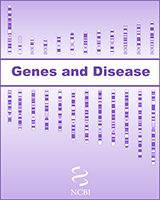NCBI Bookshelf. A service of the National Library of Medicine, National Institutes of Health.
National Center for Biotechnology Information (US). Genes and Disease [Internet]. Bethesda (MD): National Center for Biotechnology Information (US); 1998-.
Tremor, or uncontrollable shaking, is a common symptom of neurological disorders such as Parkinson disease, head trauma, and stroke. However, many people with tremor have what is called idiopathic or essential tremor. In these cases, which number 3-4 million people in the US, the tremor itself is the only symptom of the disorder. While essential tremor may involve other parts of the body, the hands and head are most often affected.
In more than half of the cases, essential tremor is inherited as an autosomal dominant trait, which means that children of an affected individual will have a 50% chance of also developing the disorder. In 1997, the ETM1 gene (also called FET1) was mapped to chromosome 3 in a study of Icelandic families, while another gene, called ETM2, was mapped to chromosome 2 in a large American family of Czech descent. That two genes for essential tremor have been found on two different chromosomes demonstrates that mutations in a variety of genes may lead to essential tremor.
While the mainstays of treatment are drugs such as propranolol and primidone, alternative drugs and surgical treatments are also available. Further understanding of the molecular mechanism behind the disease awaits the discovery and cloning of an essential tremor gene.
Related diseases
- Genome view see gene locations
- Entrez Gene collection of gene-related information
- Research articles online full text
- Books online books section
- OMIM catalog of human genes and disorders
- Factsheet from the National Institute of Neurological Disorders and Stroke, NIH
- Information from the Essential Tremor Foundation
- GeneLocus Links
- Essential tremor - Genes and DiseaseEssential tremor - Genes and Disease
Your browsing activity is empty.
Activity recording is turned off.
See more...
